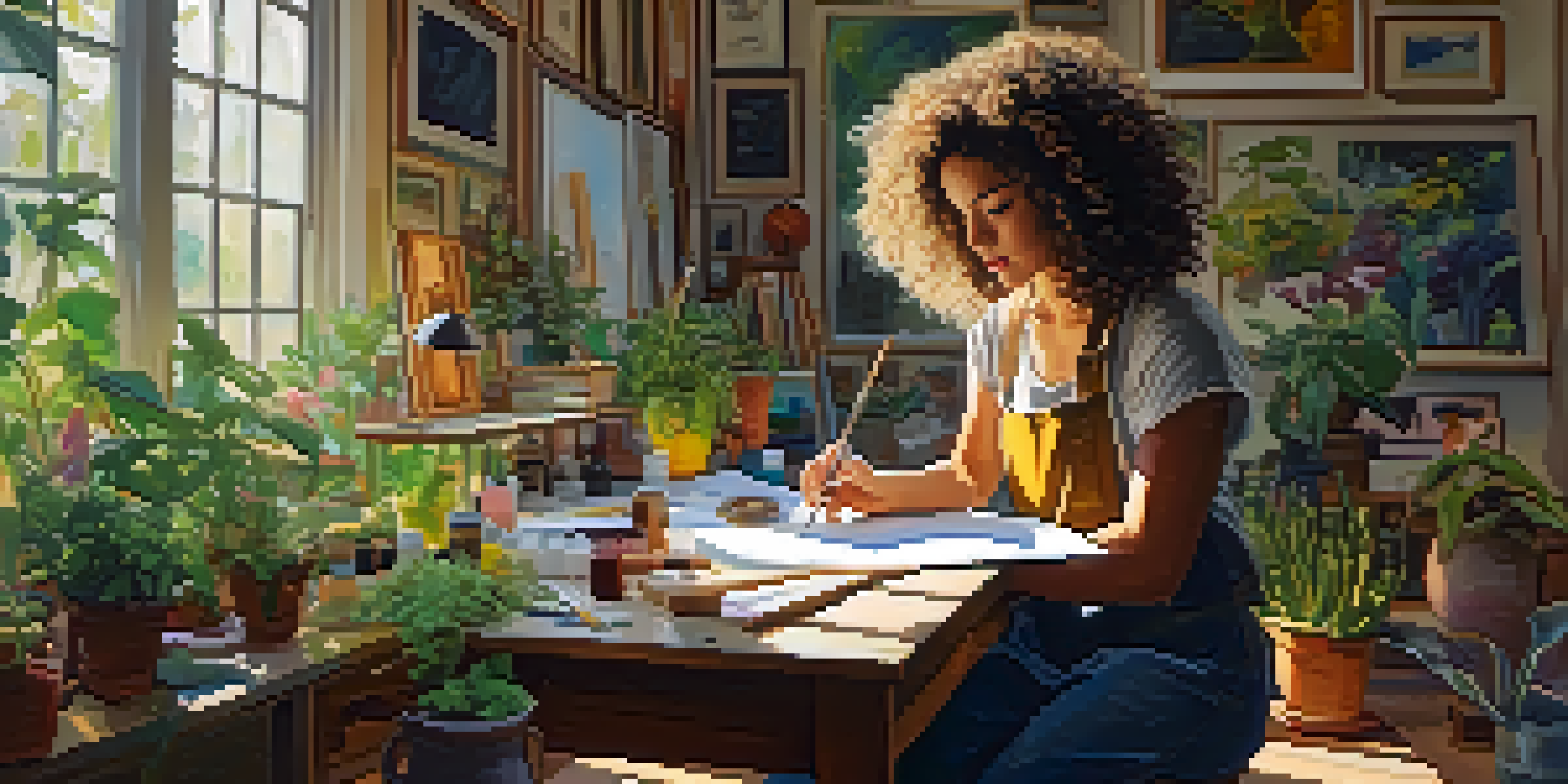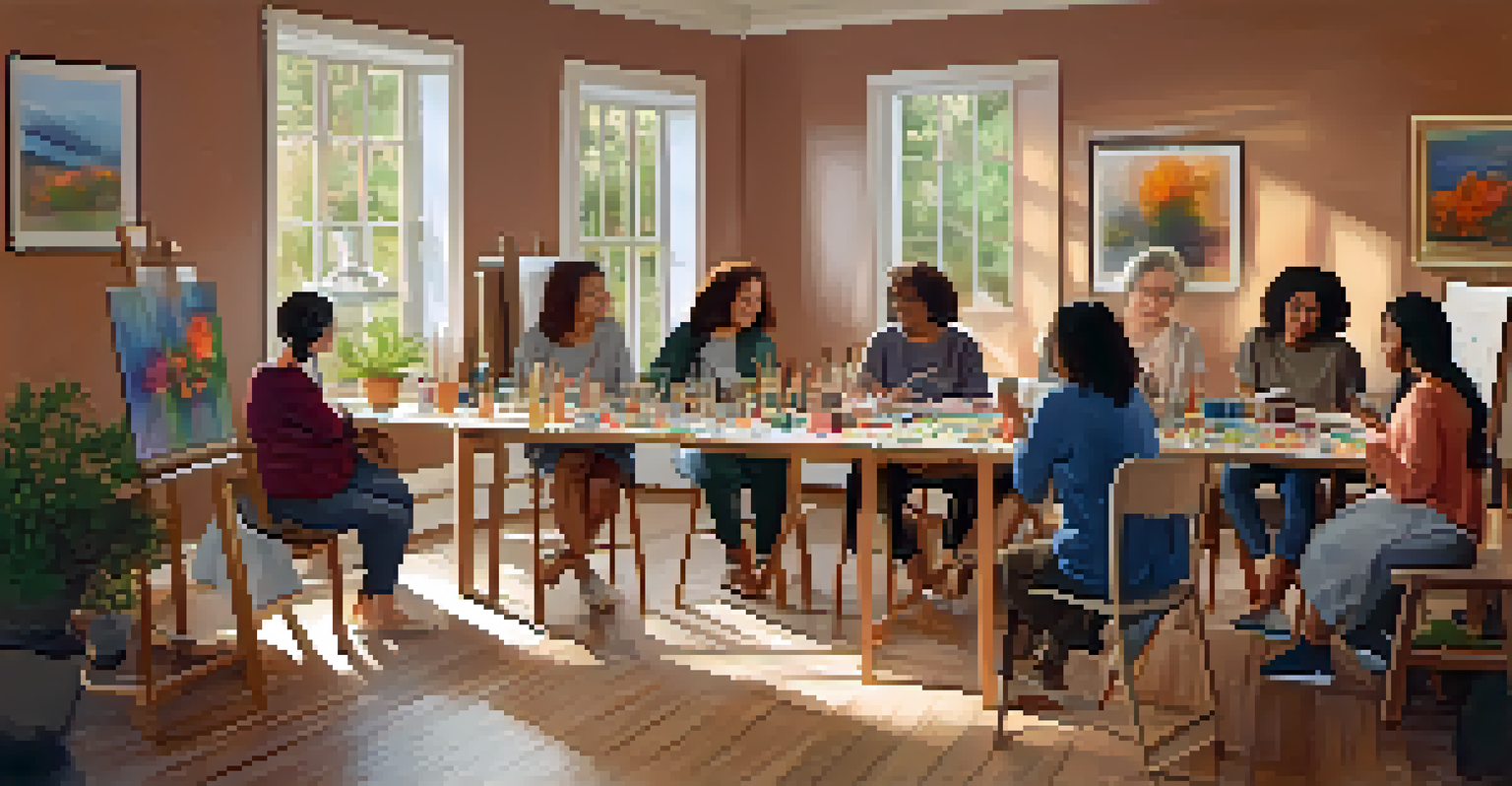Crafting Hope: How Handmade Art Promotes Resilience

Understanding Resilience Through Art
Resilience is the ability to bounce back from life's challenges, and art can be a powerful tool in this process. When we engage in artistic activities, we allow ourselves to express emotions that might be difficult to articulate. This expression can foster a sense of control and agency, crucial components of resilience.
Art enables us to find ourselves and lose ourselves at the same time.
Consider how painting or sculpting can serve as an emotional outlet. Each brush stroke or clay mold can represent a feeling or experience, providing a tangible way to process what we’re going through. This not only helps in understanding ourselves better but also strengthens our ability to cope with future challenges.
Ultimately, engaging with art can create a safe space for exploration and healing. The act of creating becomes a personal journey, reminding us that resilience is not just about survival; it's also about growth and transformation.
The Therapeutic Benefits of Handmade Art
Handmade art offers therapeutic benefits that can significantly enhance mental well-being. Engaging in creative activities has been shown to reduce stress, anxiety, and depression. The focus required to create something beautiful can serve as a meditative practice, allowing the mind to find calm amidst chaos.

For example, knitting or crocheting can be particularly soothing. The repetitive motions can provide comfort and help to ground us, making it easier to deal with overwhelming emotions. Moreover, the completed piece serves as a reminder of our ability to create and achieve, reinforcing a positive mindset.
Art Enhances Resilience and Healing
Engaging in artistic activities allows individuals to express emotions, fostering resilience and personal growth.
In essence, the therapeutic nature of creating art not only promotes relaxation but also boosts self-esteem. Each handmade piece becomes a testament to our resilience, showcasing how we can turn our struggles into something beautiful.
Community Connections Through Art
Creating art can be a communal experience that fosters connections among individuals. Group art projects or workshops allow people to come together, share stories, and support one another in their creative journeys. This sense of belonging can significantly contribute to an individual’s resilience.
Creativity takes courage.
For instance, community murals often tell a collective story, reflecting shared experiences and hopes. Participants not only leave their mark on the artwork but also strengthen their bonds with others who share similar struggles or aspirations. This collaboration can be a powerful reminder that we are not alone in our challenges.
By engaging in art as a community, we cultivate an environment of support and understanding. Such connections can enhance personal resilience, as we draw strength from the collective spirit of those around us.
Art as a Storytelling Medium for Healing
Art has long been a medium for storytelling, allowing individuals to share their experiences in a unique and impactful way. Through visual art, poetry, or performance, people can convey their journeys, struggles, and triumphs. This form of storytelling can be incredibly healing, both for the artist and the audience.
Think about how a powerful painting can evoke emotions and provoke thought. When someone sees their own experiences reflected in art, it can validate their feelings and foster a sense of connection. This shared understanding can be a catalyst for healing and resilience.
Community Art Builds Connections
Collaborative art projects create a sense of belonging, enhancing individual resilience through shared experiences.
Thus, art becomes a bridge that connects people through shared narratives. It reminds us that while our stories may differ, the emotions tied to them are universal, creating a tapestry of resilience through expression.
Personal Growth Through Crafting
Crafting is not just about creating objects; it's also a journey of personal growth. As we engage in different forms of handmade art, we learn new skills, confront challenges, and celebrate achievements. Each project can teach us patience, perseverance, and the importance of process over perfection.
For example, trying to master a new technique in pottery can be frustrating, but overcoming that frustration can lead to a sense of accomplishment. This journey mirrors life’s challenges, reminding us that resilience is often born from persistence and effort. Each crafted piece serves as a reminder of our growth.
In embracing the crafting process, we develop a greater sense of self-efficacy. The belief that we can create and overcome obstacles fosters resilience, empowering us to face future challenges with a stronger mindset.
The Role of Art in Trauma Recovery
Art plays a significant role in trauma recovery, providing a safe outlet for expression and healing. For many, the act of creating can help process trauma that words often fail to capture. It allows individuals to externalize their feelings, making them easier to confront and understand.
Consider art therapy, where trained professionals guide individuals through creative processes to explore their emotions. This therapeutic approach has shown promising results in helping people navigate their experiences, ultimately fostering resilience and healing. It highlights the power of creativity in restoring emotional balance.
Creativity Aids Trauma Recovery
Art provides a safe outlet for processing trauma, enabling individuals to reclaim their narratives and promote healing.
Thus, art becomes a crucial ally in the journey of trauma recovery. By transforming pain into creativity, individuals can reclaim their narratives and build a path toward resilience and hope.
Encouraging a Culture of Creativity
Fostering a culture of creativity is essential for promoting resilience within communities. When we prioritize artistic expression, we create environments where individuals feel safe to explore their feelings and share their stories. This cultural shift can lead to stronger, more resilient communities.
In schools, for example, integrating art into the curriculum encourages students to express themselves creatively. It nurtures emotional intelligence and adaptability, helping them develop resilience from a young age. Such initiatives can lay the groundwork for a future generation that values creativity and emotional well-being.

Ultimately, encouraging creativity is about more than just art; it's about cultivating resilience and hope in our communities. When we support one another’s creative endeavors, we contribute to a culture that celebrates growth, healing, and connection.